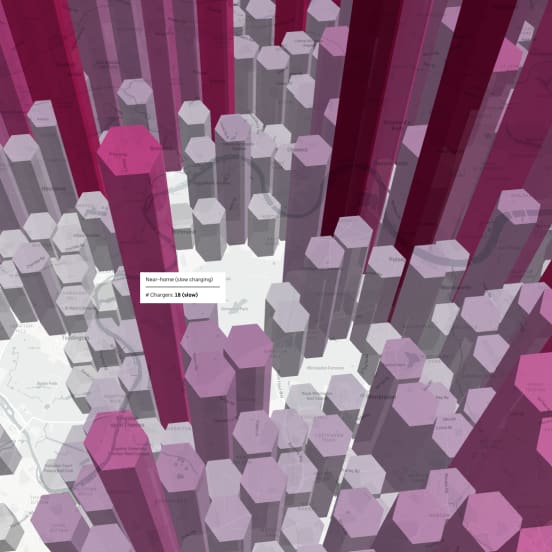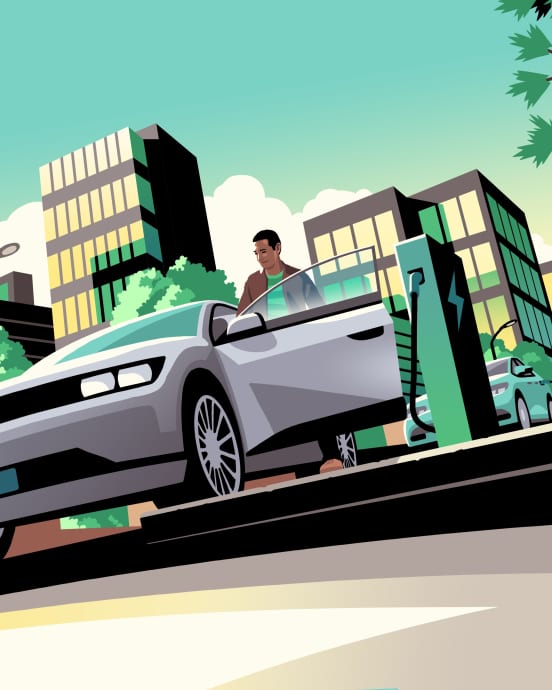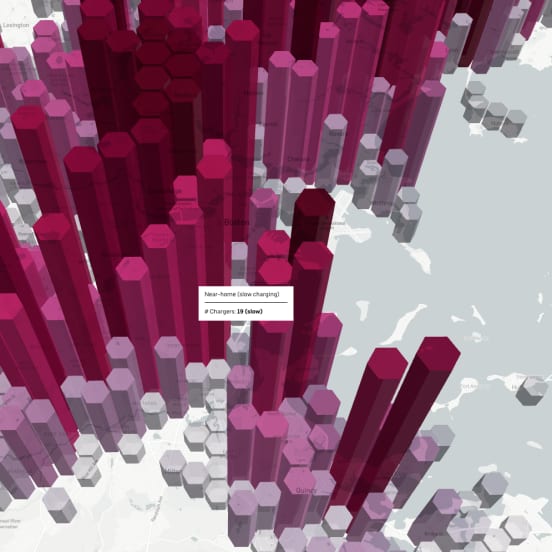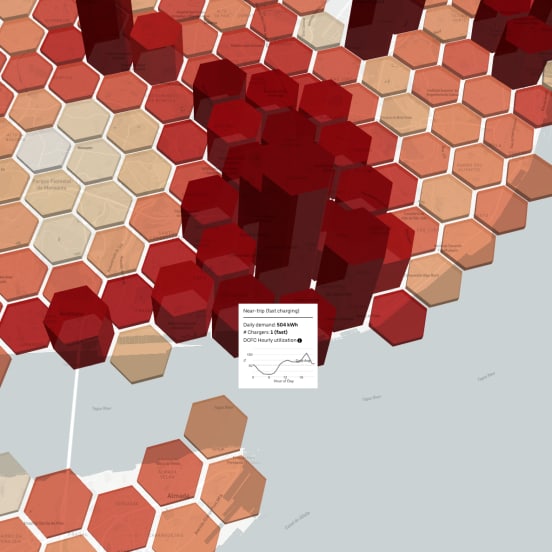Helping cities and businesses build EV charging where it’s needed
Leading cities around the world know that getting EV (electric vehicle) charging infrastructure right can accelerate mobility electrification* and economic growth.** However, governments and industry face many challenges when determining how much charging is needed and where it should go. In fact, research shows the downsides of building poorly located, underused charging.
At Uber, we’re all in on going electric, and we recognize that charging remains a top challenge for cities and drivers alike. That’s why we’re excited to introduce EVIE, Uber’s Electric Vehicle Infrastructure Estimator, an interactive analytics tool that uses recent real-world data from Uber drivers and trips to generate city heatmaps showing future scenarios of charging demand—how much and where—from EV rideshare drivers.
How EVIE, our EV Infrastructure Estimator, works
By leveraging real-world data, EVIE can help governments and businesses take some of the guesswork out of EV infrastructure planning. It aggregates data collected during the normal course of business on Uber—from millions of drivers and billions of trips—to generate heatmaps showing areas of high-potential EV charging demand.
The Estimator provides insights into where, how many, and which types of chargers (slow- or fast-charging) could best serve future EV drivers on Uber. City agencies, utilities, and businesses can use EVIE to inform how they invest in, build, and manage urban EV charging solutions.
EVIE focuses on 2 types of charging demand:
captured on June 23, 2025, at 9am PT (US). Go to EVIE Terms of Use.
.
Near-trip demand
Areas where Uber EV drivers may look to top up or fully charge in between dropping off and picking up riders. We’d expect public fast-charging infrastructure to be a likely solution for serving this demand to help EV drivers and fleets minimize downtime from revenue-generating service.
Near-home demand
Areas where Uber EV drivers may need a full charge at the end of a day or long session of offering trips. The best solutions to serve this demand will vary by city and neighborhood. For instance, overnight slow-charging solutions tend to give drivers the lowest-cost electricity options. In residential areas with more single-family homes, at-home charging may work best. In higher-density areas with more multifamily housing, a portfolio of solutions may be needed, including slow charging in parking garages and curbside, plus supplemental neighborhood fast-charging stations.
Rideshare drivers can increase the benefits of EV charging
A little charging for rideshare drivers can go a long way. Research shows that while ridesharing represents only a tiny fraction of cars on the road, EV rideshare drivers can bring a lot of utilization to EV charging sites—as much as a 10-fold increase, according to one operator.
Even better, additional research shows that when rideshare drivers go electric, they can deliver 3 times more clean air benefits to their community compared with drivers in the general public.
How cities are using EVIE
Uber is collaborating with cities to share EVIE data. The tool is designed to increase the efficiency of planning EV charging infrastructure.
Learn more in our article about how Uber used EVIE to evaluate EV charging needs for rideshare drivers in Greater Boston.
captured on June 23, 2025, at 1pm PT (US). Go to EVIE Terms of Use.
.
Getting started
We’re sharing EVIE with employees of government agencies, utilities, and energy companies who are actively working to develop EV charging infrastructure.
If you received an invitation from Uber to access EVIE:
- Create an Uber account at Uber.com using your work email address
- Uber will notify you once your account has been onboarded to EVIE
- Select Launch EVIE below
- Sign in to your Uber account using your work email
- Acknowledge EVIE’s Terms of Use, and start using EVIE
captured on June 23, 2025, at 1pm PT (US). Go to EVIE Terms of Use.
.
Gyakori kérdések
- How can I start using EVIE?
Invited users can access EVIE with an active Uber account after acknowledging the Terms of Use. We’re sharing EVIE with employees of government agencies, utilities, and energy companies who are actively working to develop EV charging infrastructure. Go to the “Getting started” section of this page for steps to take.
- Can I share EVIE with my colleagues or our EV charging partners?
To access EVIE, users need to be invited, have an active Uber account, and acknowledge our Terms of Use. Go to the “Getting started” section of this page for more information. Contact evie-support@uber.com to recommend colleagues who are actively working on EV charging infrastructure in your city.
- How much does access cost?
EVIE access is free for invited users.
- Are there any usage restrictions on the data?
Please review the latest Terms of Use for details.
- Does EVIE cover my city?
EVIE currently includes 40 metro regions globally—covering nearly 60% of battery EV drivers on Uber around the world—each often including many cities and municipalities. Please send an email to evie-support@uber.com to find out if your city is one of them. EVIE does not include every global city and can only generate EV charging demand scenarios for metro areas where Uber operates and observes a sufficient amount of user activity.
- What kind of data will I find in EVIE?
EVIE produces urban heatmaps that forecast EV charging demand scenarios by future EV drivers on Uber. For any given scenario, output consists of 2 components: where EV charging demand may occur, shown across a grid of hexagons using the open-source H3 index, and the amount of EV charging that may be demanded. The amount of charging shown differs according to the display mode:
Near-trip: This displays both the number of fast-charging (Level 3, or L3) ports required to fulfill the peak hourly expected electricity demand and the daily total electricity demand (in kilowatt-hours, per day)
Near-home: This displays the number of slow-charging (Level 2, or L2) ports required to fulfill expected overnight demand
For more details, read EVIE’s technical methodology.
- What’s H3?
H3 is a geospatial indexing system that partitions the world into hexagonal cells. Engineers at Uber developed H3 and made it open source under the Apache 2.0 license.
- Can I download data from EVIE?
Yes. The tool supports CSV (comma-separated values) file downloads. The CSV data has an H3 index to support various geospatial analysis tools.
- Is EVIE interactive?
Yes. Users can visually interact with the data and adjust key assumptions to generate multiple scenarios. For example, users can:
- Zoom and pan to better survey EV charging demand scenarios across cities and greater metro areas
- Toggle between near-trip and near-home demand scenarios (get more information above)
- Adjust the assumed ratio of charging demand fulfillment by EV rideshare drivers between at- or near-home versus near-trip
- Adjust the assumed future level of battery EV uptake by Uber drivers to anywhere between 25% and 100% of trip miles completed (you can find data on current levels and historic trends of Uber driver EV uptake for key geographies here)
- Can EVIE data be applied to the on-demand delivery sector?
No. The current version is based on drivers who are eligible for ride trips. In some cities, some drivers may also complete delivery trips, but these generally make up a fraction of all drivers and trips.
The images and information contained herein and in EVIE are for informational purposes only and should not be relied upon to make any business or policy decisions. Use of EVIE is governed by the EVIE Terms of Use.
*California: “The impact of EV charging stations on light-duty EV adoption in California,” Center for Sustainable Energy (June 2023), energycenter.org/thought-leadership/research-and-reports/impact-ev-charging-stations-light-duty-ev-adoption. EU: “Assessing the impacts of electric vehicle recharging infrastructure deployment efforts in the European Union,” MDPI Energies (June 22, 2019), doi.org/10.3390/en12122409. Germany: “Public charging infrastructure and the market diffusion of electric vehicles,” Transportation Research Part D: Transport and Environment (September 2020), doi.org/10.1016/j.trd.2020.102413. Norway: “Technology adoption and early network infrastructure provision in the market for electric vehicles,” Environmental and Resource Economics (July 7, 2022), doi.org/10.1007/s10640-022-00703-z. US: “The role of demand-side incentives and charging infrastructure on plug-in electric vehicle adoption: analysis of US states,” Environmental Research Letters (July 13, 2018), iopscience.iop.org/article/10.1088/1748-9326/aad0f8.
**"Estimating the economic impact of electric vehicle charging stations,” Argonne National Laboratory (March 16, 2022), anl.gov/article/estimating-the-economic-impact-of-electric-vehicle-charging-stations. “Study: EV charging stations boost spending at nearby businesses,” MIT News (September 4, 2024), news.mit.edu/2024/study-ev-charging-stations-boost-nearby-business-spending-0904.
Rólunk




